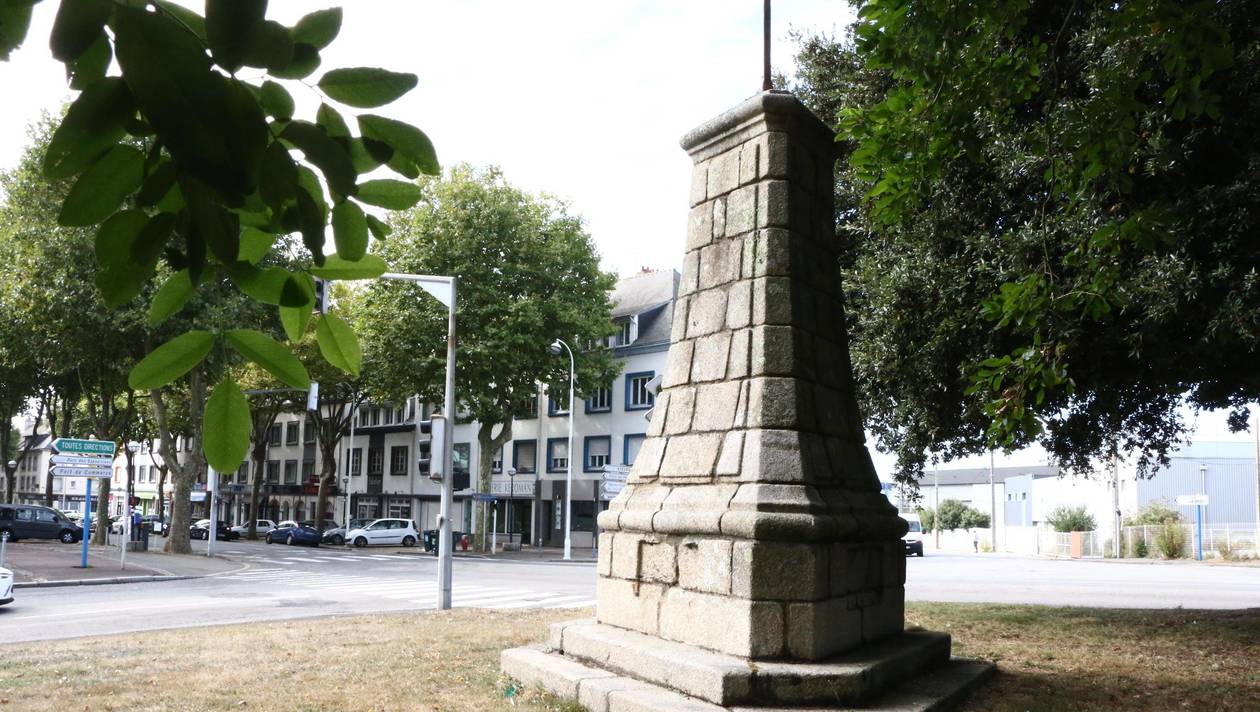It is a small monument of the eighteenth century, not well known in Lorient and one of four local sites listed in the inventory of historic monuments. A plaque, inaugurated this Saturday 15th September, explains its history.
The Croix de la Verite (Cross of Truth) finally explained. After the work of fans of the local history and research association of Lorient, more recently by Maryse Leroux, the mayor decided to install a plaque at the foot of this monument, of so little is known in Lorient.
It is inaugurated this Saturday 15th September at 11 am, as part of the Heritage Days . Located at the traffic lights between the Carnel bridge and the Avenue de la Perrière, the cross is partly hidden by the trees. In the end, we do not pay much attention to it. Yet his presence tells a side of the story of Lorient “very singular” , as says the heritage service of the city.
He had stolen two chalices

The story takes place in the 18th century. On the 5th February, 1711, Giuseppe Grapallo (or Gropello) was hanged in a public place, in Lorient. His body is burned and his ashes thrown to the wind. The Genoese sailor, a sailor on a French pirate ship, pays a sacrilege.
For, in the night of October 19th to 20th, 1710, in stopover in Lorient, he stole two chalices at the Saint-Louis church. “These two chalices were the main silverware of this poor church,” says a century later the Lorient historian François Jégou (1825-1890), whose research was invaluable to lift the Croix de la Verite from oblivion.
By order of Louis XIV

Giuseppe Grapallo had buried the chalaces in the mudflat of Kergroise. In memory of the event, a cross was erected where the sacred vessels had been hidden. «On the edge of the road from Lorient to Saint-Michel Island, on the old moor of Bec er Groix, today named la Perrière» , still recalls François Jégou.
The monument was erected by order of Louis XIV: granite stone, pyramidal shape, slightly curved, with sloping ridges. The monument is surmounted by a metal cross. It has been called the Croix de la Verite (Cross of Truth), the expiatory symbol of the Genoese sailor’s pass and also a symbol intended to impress the population, “to contain the people in their duty,” reports François Jégou.
The cross was moved

In 1905, the cross is removed by decision of the city council. Then reinstalled eleven years later, a few hundred meters from its original anchorage. Where she is today.
Saturday 15th September, 11 am, inauguration of the plate of the Croix de la Verite (located at the traffic lights of the Carnel Bridge and the Avenue de la Perrière, opposite the School of Fine Arts in Lorient).
The Heritage Days program in Lorient: click here
Three languages for three plates

A sign to explain to the people of Lorient what the Croix de la Verite represents. But will the monument will have three plates, sealed in its base, which is related to its history? One in French, the other in Breton and another in Latin.
The location of the plates is still very visible, embedded in the granite base. Each plate measured 72 cm by 37 cm, according to the rating recorded by Pierre Mayol of the group of associations of local history of the country of Lorient.
Here is the original text of each plate, with the spelling of the time, according to the abbot Le Cam (1885-1948).
In French
“Cette croix a été posée en 1711 par l’ordre de Louis Le Grand, en réparation du sacrilège commis dans la nuit du 19 au 20 octobre par un matelot génois qui ayant volé deux ciboires dans l’église paroissiale de Lorient, les enterra en ce lieu et fut brûlé le 5 février 1711, en exécution de l’arrêt du Parlement de Bretagne du 21 janvier 1711.”
Translation to English: “This cross was laid in 1711 by the order of Louis Le Grand, in compensation for the sacrilege committed in the night of 19 to 20 October by a Genoese sailor who stole two ciboriums in the parish church of Lorient, buried them in this place and was burned on February 5, 1711, in execution of the decree of the Parliament of Brittany of January 21, 1711. »
In Breton
“Er groés man a zob bet pozet er bléee mil seih cant unec, dré ordre er Roué Loüais peourdecvet, evit reparign er sacrilège commettet en noz ac en nandecvet dée a viz héré er blée mil seih cant dec, dré ur martelot ganet hé Gene péhani goudé hen dohoüai lairet deaux ciboëres an ilis parèce ac en Orient, en hou interàse er place man-eüit he pehet ha ma bet losquet er pempet déé a viz hüeavrer, er blée mil seih cant unec, dré arest er parlemant ha Vreiz, reit en dée arnuiguent a viz guenver ag er blée mil seih cant unec”
In Latin
“Ad expiandum nautoe cujusdam alienigenoe scelus, qui nocte octobris a surreptas in Ecclesia paroeciali Orientis duas pixides sacras hic infodit, et senatus Armorici decdeto existus est die 5° febr – M D C C X I.”




